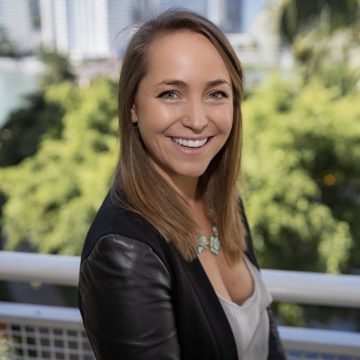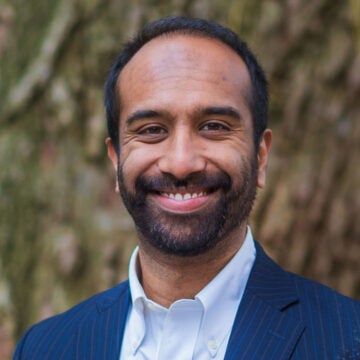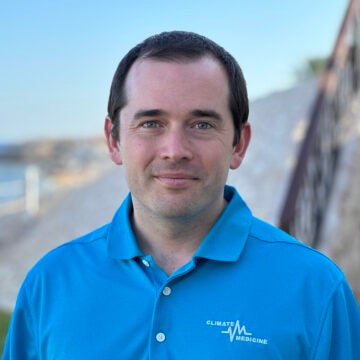BOSTON, MASSACHUSETTS — “I learned that at my age I have a lot of power, that I can make my voice heard,” said Iffah Merchant, a 15-year-old from Columbus, Georgia. “Now, I know just how impactful I can be.”
That was a key takeaway from students at the third Youth Summit on Climate, Equity, and Health this July at Harvard T.H. Chan School of Public Health.
In collaboration with Putney Pre-College, the annual summit from Harvard Chan’s Center for Climate, Health, and the Global Environment brought together 85 high school students from across the globe for speeches, seminars, and talks from over three dozen guest speakers.
Students traveled from over twenty states and five countries with one common goal in mind — to understand the connections between climate and health and channel that knowledge into actions that protect people from the growing risks of climate change.
Attendees have faced a wide range of climate impacts in their communities. From extreme weather to drought to unprecedented heat to environmental justice challenges, they all brought their experiences to the summit.
“My home has definitely impacted my involvement with climate work,” said 16-year-old Mischa Yen. Living in Southern California, “extreme rainstorms have brought heavy rainfall and snowmelt in the recent months. Mudslides were triggered, bridges were collapsing, power outages were occurring, and many lost their homes.”
Alexandria Viger has faced other environmental threats in recent years, which were exacerbated by climate change and heightened by her community’s lack of resources and high rates of poverty.
“People who are stuck in poverty are most vulnerable to climate change and its damage,” said 16-year-old Viger. “And Jackson, Michigan has been a hotspot with a water crisis that has had deadly effects over the past couple of years.”
With hopes of finding like-minded individuals to drive change, 17-year-old Querida Alleyne and others applied to the summit.
“I’m from a small city in New Jersey where the majority of the population are immigrants, Latino or Black, and are low income. Simply put — climate change isn’t on the forefront of their minds,” said Alleyne.
With no one involved in the same work back home, she has faced a “lot of fear — arguably paralyzing — in being one of the first to involve myself in the climate space.”
A common interest sparks
“Once you get to college you have a lot of opportunities. If you are in high school, the opportunities are fewer,” said Harvard Chan School’s Vish Viswanath. “To catch the students early on, seek their help, and mobilize them, it will lay the foundation as they grow older.”
“By fostering that conversation and providing that platform, C-CHANGE is making a big difference,” he added.
The students were divided into seven focus groups based on their shared interests: climate communications, press, and media; climate science; entrepreneurship, industry, and technology; environmental justice; global health, epidemiology, and infectious diseases; medicine and healthcare; and policy and advocacy.
Each group — ranging from eight to 18 students — took a deep dive into their subject by attending speaker presentations and daily seminars.
This year had the most “diverse perspectives in the climate and health space,” said Phil Dahlin, sustainability director at Johnson & Johnson.
In his talk to the medicine and healthcare group, Dahlin covered the intersection of healthcare and climate through both direct and indirect pathways, like how extreme weather can impact vaccine distribution.
A new perspective to broaden horizons
Alongside the speakers were nine content creators who followed less traditional paths in pursuing climate activism. They were featured by C-CHANGE and Pique Action as Climate Creators to Watch for producing original, entertaining, and educational content that’s reshaping the climate narrative, combating misinformation, and empowering people to take climate action.
“I believe in making climate communications inviting, non-judgmental, and relatable; that you don’t necessarily have to have an environmental science degree to be a climate communicator,” said influencer Lauren Bash.
Bash shares sustainable lifestyle tips with her followers across TikTok, Instagram, and YouTube. She reminded students that their stories and lived experiences matter and that we all have a story to tell.
Not just a week of content, but of collaboration
When students were not learning the curriculum, they explored Boston and Cambridge during the hottest July the world has ever recorded — the threat was felt first-hand.
They channeled this call to action into two climate plans: individual and group.
As individuals, they crafted plans that took the knowledge from the summit and applied it to a problem back home.
As groups, students channeled their learnings from the week into practical and creative projects, which they presented on the last day of programming.
Ideas ranged from creating a “Climate Tank” — which took small-scale, climate-based problems and applied practical solutions — to a website based in effective climate communication to a magazine describing the basics of environmental justice inequities..
Channeling hope beyond the summit
From social media to government, the “responsibility may be apparent, but the opportunities are endless,” said Aaron Bernstein, former C-CHANGE director and current director of the National Center for Environmental Health & Agency for Toxic Substances & Disease Registry at the CDC.
As students set off to all corners of the world, speakers had one important piece of advice for them: find your own place within the movement to form a compelling narrative that will inspire others to follow suit.
In his keynote speech, Gaurab Basu, a primary care physician and Director of Education and Policy at C-CHANGE, spoke to the importance of sharing your own narrative, “You have to find what you care about. We are all here because we care about this, but we need to translate this so everyone should care.”
In looking back at their favorite moments of the week, some students spoke about the impact of being surrounded by like-minded individuals had on them.
Fourteen-year-old Ryan Lo of Moraga, California said, “I’ve learned that to truly inspire someone, you have to make them feel: feel like a part of the solution, feel threatened by what we’re up against, or feel concerned for those they care about,”
Celine Chein of Menlo Park, California, said it “felt fulfilling to be able to engage in this educational discourse with peers who had similar interests, but simultaneously diverse backgrounds and perspectives,” the 15-year-old said.
Similarly, 17-year-old Finn Does of San Francisco, California stated, “We took our summit as an opportunity to generate community and optimism — the energy that will fuel our movement. I am inspired by our power when we collectivize, by our ongoing resilience in the face of this crisis.”



